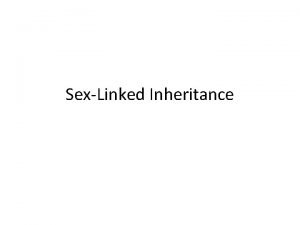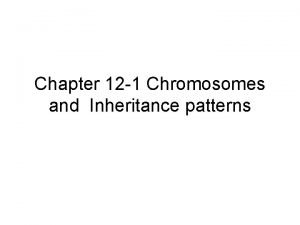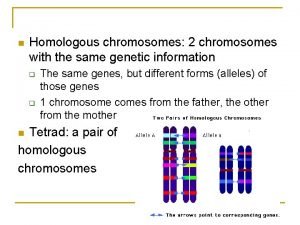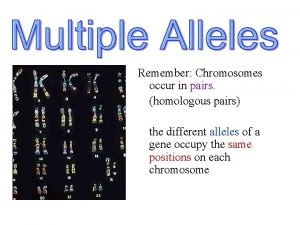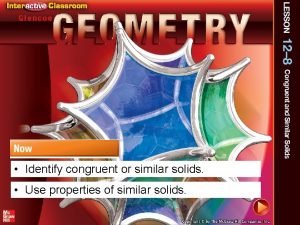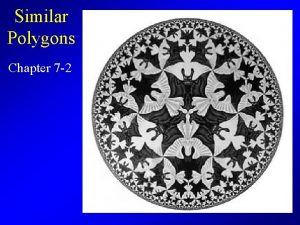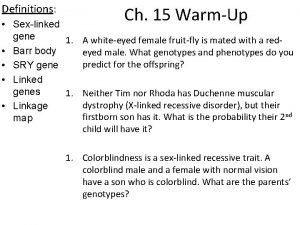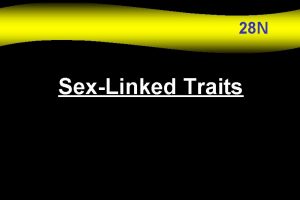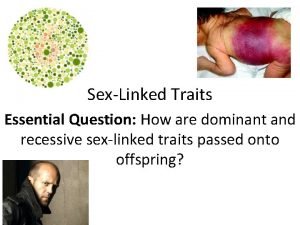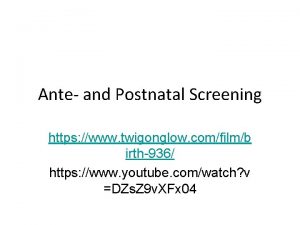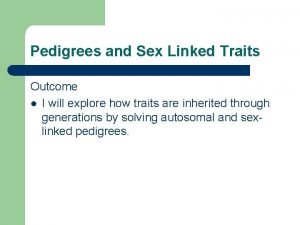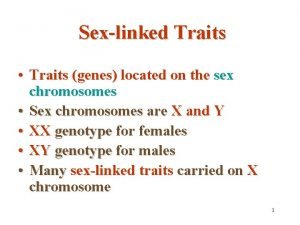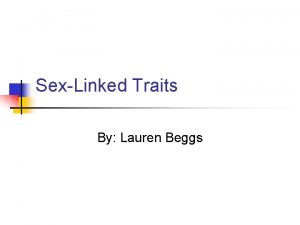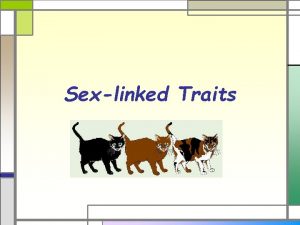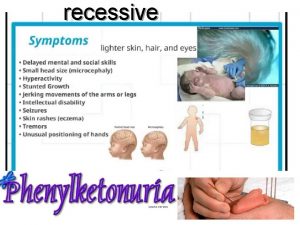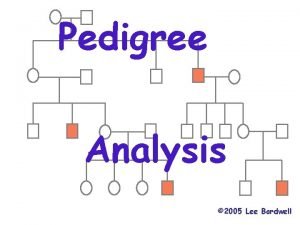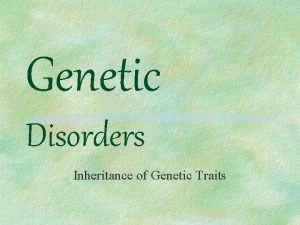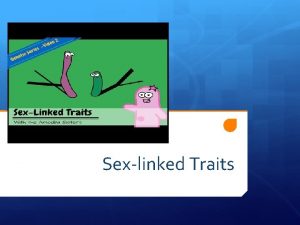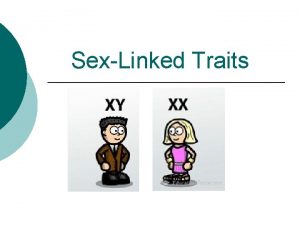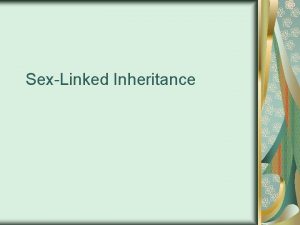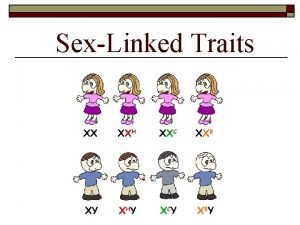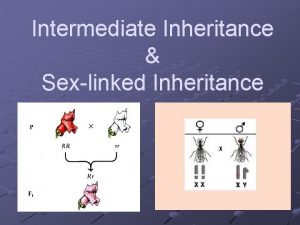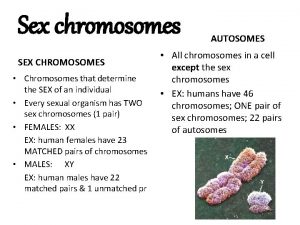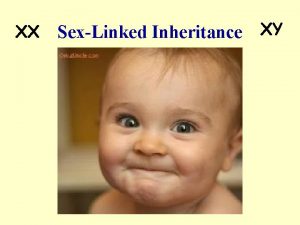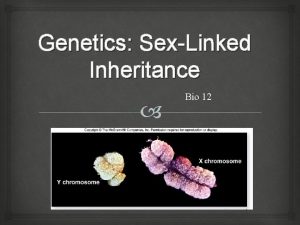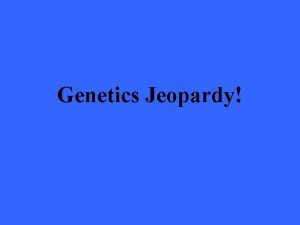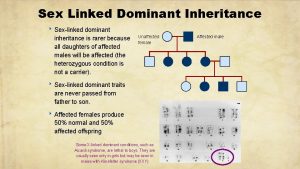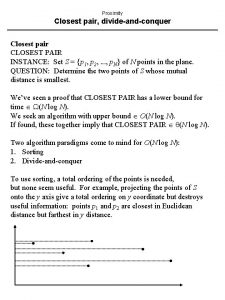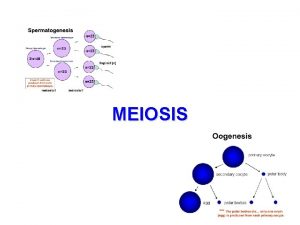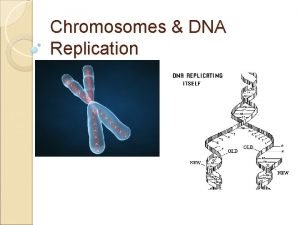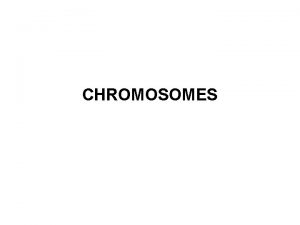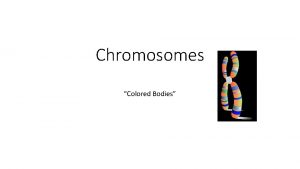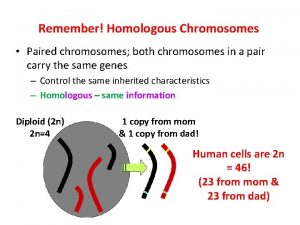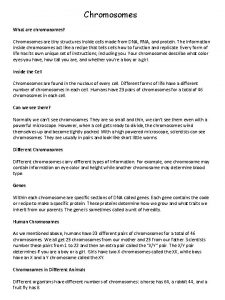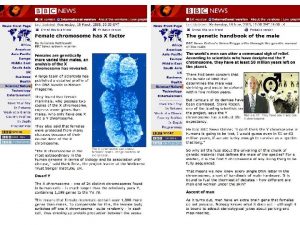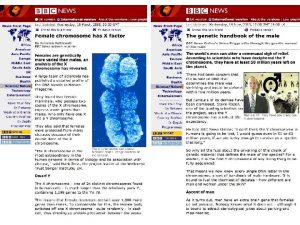SexLinked Inheritance The pair of chromosomes that determine































- Slides: 31

Sex-Linked Inheritance

The pair of chromosomes that determine the sex in humans is called the sex chromosomes, XX for female and XY for male. The nonsex chromosomes are called autosomes

Drill 1. The pair of chromosomes that determine the sex in humans is called the sex chromosomes, XX for female and XY for male. What are the nonsex chromosomes called? Answer: AUTOSOMES

Drill#5 Use a Punnett Square to… • Determine the chance of having a boy…

Use a Punnett Square to… • What is the chance of having a boy? X X Y X

Use a Punnett Square to… • What is the chance of having a boy? 50% X Y X X XX XX XY XY

Drill 2. In cats, curled ears (Cu) result from an allele that is dominant over an allele for normal ears (cu). Black color results from an allele (B) that is dominant over an allele for gray (b). A gray cat homozygous for curled ears is mated with a homozygous black cat with normal ears. All the F 1 cats are black and have curled ears. a. If two of the F 1 cats mate, what phenotypes and proportions are expected in the F 2? b. An F 1 cat mates with a stray cat that is gray and has normal ears. What phenotypes and proportions of offspring are expected from this cross?

Preparation of Karyotype • Cells from blood or amniotic fluid are grown in a culture dish. • Cell division is then stopped in metaphase with colchicine, a protein that inhibits mitotic spindle from forming • Cells are centrifuged to release the chromosomes. • Chromosomes are stained, photographed, and grouped by size and banding patterns

Karyotype

Karyotype

Sex Chromosomes • The Y chromosome is acrocentric and much smaller than the X chromosome.


Sex Determination in Humans • Humans have XX-XY sex determination. • The presence of a gene (SRY) on the y chromosome codes for maleness. • Certain phenotypes result from abnormal numbers of sex chromosomes which arise when sex chromosomes do not segregate properly in meiosis or mitosis. • Studying these abnormalities illustrates the importance of the Y chromosomes.

Turner Syndrome

Turner Syndrome


Klinefelter’s syndrome

Klinefelter Syndrome

Poly – X Female

Poly – X Female • Triplo X or poly X females occur in about 1 in 1000 female births • No distinctive features other than being tall and thin • Many are fertile • Slightly greater incidence of retardation as the number of X chromosomes increase.

Nondisjunction

Role of Sex Chromosomes • The x chromosome contains genetic information essential for both sexes; at least one copy of an X-chromosome is required for human development • The male determining gene is located on the y chromosome. A single copy of this chromosome even in the presence of several X chromosomes produces a male phenotype. • The absence of the Y chromosome results in a female phenotype. • A female needs at least 2 copies of the X chromosome to be fertile. • Additional copies of the X chromosome may upset normal development of both males and females producing physical and mental problems.

Sex linked inheritance • Characteristics determined by genes on the sex chromosomes are called sex linked characteristics. • Diploid females have 2 alleles at each x-linked locus • Diploid males possess a single allele on 1 xlinked locus.

Sex linked inheritance • Females inherit X-linked alleles from both parents • Males inherit a single X-linked allele from their mother.

Sex linked inheritance

Sex-Linked Inheritance • Color blindedness • Hemophilia

Summarizing Questions 1. Colorblindness in humans is most commonly due to an X-linked recessive allele. Betty has normal vision, but her mother is colorblind. Bill is color blind. If Bill and Betty marry and have a child, what is the probability that the child will be color blind?

Summarizing Question 2. Hemophilia results from a recessive X-linked gene. Jill has hemophilia. She marries Bill, who has normal blood clotting. What proportion of their children are expected to have hemophilia?

Summarizing Question 3. Joe has hemophilia, an X-linked recessive disease. Could Joe have inherited the gene for the disease from the following persons? a. his mother’s mother b. his mother’s father c. his father’s mother d. his father’s father

Home Assignment • Due Monday, January 9 th. Use Chapters 10 and 11 or the internet to answer the following questions. 1. Describe how one DNA strand directs the synthesis of another. 2. How does a cell copy both strands of DNA simultaneously? 3. Draw a strand of DNA, label the phosphate groups, the ribose, the nitrogen bases (ATCG), the 3’ end and the 5’ end. 4. What are Okazaki fragments?

5. What is the ultimate source of genetic diversity? 6. There are two types of mutations, point and chromosomal. List 3 types of point mutations and 4 types of chromosomal mutations. 7. Explain Francis Crick’s “Central Dogma”. Define transcription and translation.
 Sexlinked inheritance
Sexlinked inheritance Section 12-1 chromosomes and inheritance
Section 12-1 chromosomes and inheritance What is homologous chromosome
What is homologous chromosome Homologous chromosomes
Homologous chromosomes Python unordered pair
Python unordered pair Rolling pair is higher pair
Rolling pair is higher pair Phân độ lown
Phân độ lown Chiến lược kinh doanh quốc tế của walmart
Chiến lược kinh doanh quốc tế của walmart Gây tê cơ vuông thắt lưng
Gây tê cơ vuông thắt lưng Block xoang nhĩ
Block xoang nhĩ Tìm độ lớn thật của tam giác abc
Tìm độ lớn thật của tam giác abc Thơ thất ngôn tứ tuyệt đường luật
Thơ thất ngôn tứ tuyệt đường luật Hãy nói thật ít để làm được nhiều
Hãy nói thật ít để làm được nhiều Sau thất bại ở hồ điển triệt
Sau thất bại ở hồ điển triệt Thơ thất ngôn tứ tuyệt đường luật
Thơ thất ngôn tứ tuyệt đường luật Tôn thất thuyết là ai
Tôn thất thuyết là ai Determine whether the solids are similar
Determine whether the solids are similar Similar polygons
Similar polygons Sry gene y chromosome
Sry gene y chromosome Sexlinked traits definition
Sexlinked traits definition Sexlinked traits
Sexlinked traits Phenylketonuria is autosomal or sexlinked
Phenylketonuria is autosomal or sexlinked Is methemoglobinemia autosomal or sexlinked
Is methemoglobinemia autosomal or sexlinked Hemophulia
Hemophulia Sexlinked traits definition
Sexlinked traits definition Sexlinked traits
Sexlinked traits Xyy syndrome
Xyy syndrome Sexlinked traits examples
Sexlinked traits examples Pku dominant or recessive
Pku dominant or recessive Sexlinked vs autosomal
Sexlinked vs autosomal Hemophilia sex linked punnett square
Hemophilia sex linked punnett square Patau syndrome
Patau syndrome
